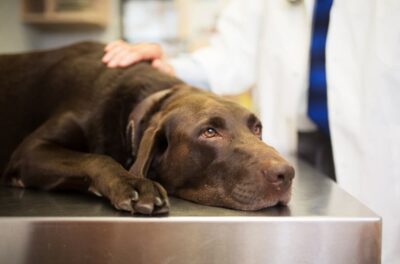All About Dog Depression

Overview
- Dogs can experience depression and sadness.
- Dog depression can happen due to stress, routine changes, or pain.
- Symptoms include lowered tail and ears, sleeping more, lack of interest in food.
- Vets may prescribe antidepressant medication to relieve depression and anxiety.
- Regular exercise, play, veterinary checkups, and a healthy diet can prevent depression.
People suffering from depression will exhibit cognitive and behavioral signs. They will sleep more, be less active or inactive, and show little to no interest in doing the things that they previously enjoyed. They appear sad, tired, and have a decreased appetite. They have trouble thinking clearly and problem solving.
People can also verbalize when they are feeling unhappy. Unfortunately, dogs cannot tell us when they are feeling lonely, sad, or yes, even depressed.
Do Dogs Get Depressed?
There is evidence that dogs can experience depression, especially if there has been a stressful or traumatic change in their lives. However, some dogs may experience depression relating to the worsening of an anxiety disorder.
Exposure to people, other animals, situations or environment that increases the dog’s overall level of stress can cause depression.
Depression is typically seen in middle-aged to senior dogs. For some dogs that suffer from an anxiety disorder, depression may be the result of their coping mechanisms failing.
What Causes Dog Depression?

There are several potential factors that could contribute to canine depression. These include:
- Addition of a new family member (infants, adults, new pet)
- Loss of a family member
- Loss of another animal housemate (dog or cat)
- Recent move
- Change in lifestyle
- Being rehomed to a new family
- Being abandoned
- Increasing levels of stress and anxiety
- Underlying medical condition
Dogs can form strong bonds to their pet parents, other animal housemates, or other dog friends. When there is a disruption in the bond, such as the death of a family member or another pet in the household or even the addition of new family members, it can produce a lot of stress, anxiety, and depression.
Dogs do not understand death the way people do. When the person or pet disappears, it leaves a gap in the dog’s life. Their daily routine is disrupted. If the dog is always walked by a particular family member at the same time every day, and that person is no longer there, the dog is left confused.
While the loss of a person can be devastating to dogs, the addition of family members in the house also lead to depression. If a new baby or pet comes into the picture, the attention of pet owners is usually split.
Having another person or pet in the house can also produce more stress. There is more noise, activity, and usually a change in a dog’s daily routine. Some dogs have a difficult time coping with these changes.
Dogs that are experiencing pain or suffering from certain medical conditions may lose interest in playing, going on walks, and eating. Dogs do not always show pain in a visible or audible way.
Some conditions that can cause pain and affect a dog’s quality of life include infections of the ear, skin, or bladder, degenerative joint disease, osteoarthritis and inflammatory bowel disease.
Any form of chronic stress whether related to a medical condition or a change in the dog’s daily routine can contribute to a dog developing depression.
Dog Depression Symptoms

Since dogs cannot verbalize that they feel depressed, we need to observe their behavior and body language to determine if they are suffering from depression.
Visible signs of depression in dogs include:
- Head held lower
- Ears held to the side or back
- Tail hanging down
- Slow response to verbal cues/commands
- Sleeping for prolonged periods of time
- Lying down for prolonged periods of time
- Decreased interest in food or treats
- Decreased interest in going out for a walk or car ride
- Decreased interest in playing with toys or people
Similar to people, when dogs are depressed, they are generally less active and show less interest in doing things they previously enjoyed. A depressed dog may no longer find joy in playing with toys, going for walks, running around in the yard, or even eating meals or treats.
Diagnosing Your Dog With Depression
Canine depression is an uncommon behavioral disorder. It is determined after ruling out medical diseases and after taking a detailed history on how the dog behaves and what is going on in his life.
There is no specific test to diagnose canine depression. If your dog exhibits a sudden change in behavior, he should first be examined by your veterinarian to determine if he is experiencing a medical problem.
Your veterinarian may recommend diagnostic blood work and a urinalysis to rule out medical conditions given the age and health of your dog. If pain is suspected, the doctor may recommend radiographs, such as X-rays, to look for a root cause.
Once your dog is deemed physically healthy, your veterinarian may make the diagnosis of depression. Your veterinarian may also refer you to a veterinary behaviorist for a more definitive diagnosis and comprehensive treatment plan.
Depression vs. Hypothyroidism in Dogs
There are some medical conditions that may look similar to canine depression such as hypothyroidism. Dogs with hypothyroidism may be slower moving and may not show interest in being active or interactive with family members.
Determining if a dog has hypothyroidism requires further diagnostic testing. Costs of additional testing may vary from $300-$500 depending which tests are recommended. If your dog is diagnosed with a medical problem and treatment is pursued, the clinical signs that were mimicking depression should resolve.
How to Treat Canine Depression

Treatment of canine depression often involves the use of anti-anxiety medication along with behavioral management.
The cost of seeing a behavior specialist can range from $300-$800, depending on the services that they provide in addition to the initial consultation.
A behaviorist will recommend a treatment plan that is tailored to your dog. This may involve teaching coping mechanisms for dealing with fears and phobias, or recommending certain exercises or bonding activities for your family and your dog.
In addition to medication therapy and working with a canine behaviorist, there are some steps pet owners can take to help improve their dog’s quality of life at home. These include:
- Providing 15-20 minutes of exercise daily with walks or play time
- Enriching your dog’s environment with puzzle toys and mental stimulation
- Spending more time with your dog (talking to him, petting him, grooming, etc.)
Sometimes depression can improve on its own, with time. However, it can take several months to resolve. The dog may experience a poor quality of life in the interim. He may have a higher level of stress, weight loss, and possibly experience muscle atrophy, if the depression does not improve.
It is best to intervene early to break the cycle of depression in dogs.
Medication for Depression in Dogs
The most common medications used to treat depression in dogs are human antidepressants such as selective serotonin reuptake inhibitors (SSRIs) and tricyclic antidepressants (TCA). Pet owners should not give their pets these medications unless instructed by a veterinarian to do so.
The most commonly used SSRIs used to treat depression in dogs are:
- Fluoxetine (generic Prozac)
- Paroxetine (generic Paxil)
- Sertraline (generic Zoloft)
These medications increase the serotonin level in a dog’s brain, which helps modulate mood and behavior. They usually need to be given for 4-6 weeks before seeing an effect or improvement in mood. These medications are dispensed in capsule or tablet form and given to dogs once daily. The general cost is approximately $10-$50 per month.
The most common TCA used in dogs is clomipramine or Clomicalm.
This medication modulates serotonin and norepinephrine receptors to reduce anxiety in dogs. This medication takes 4-6 weeks to take effect and is typically given twice daily to reduce gastrointestinal upset.
Clomicalm is a flavored chewable tablet. The general cost is approximately $40-$100 per month.
How to Prevent Depression in Dogs

Depression is a complicated condition, and it cannot always be prevented in dogs. Certain life changes or circumstances may cause your dog to feel sadness or stress. But ensuring that your dog is medically healthy, active, and enriched may help prevent the onset of depression.
Pet parents should exercise their dogs daily, going on walks together or dedicating time to play. Keep these activities new and engaging by switching up walking routes or incorporating new toys. Continuing to teach your dog new cues and tricks can keep him mentally stimulated.
Additionally, you can provide new and interesting smells in your home to enrich your dog’s environment and keep it exciting. Sheep wool or rabbit fur might be welcome scents for your dog, or you can purchase deer musk from hunting supply stores.
If your dog is not fearful of the car, take rides to expose your dog to new sights and sounds. This can keep his mind active and engaged.
In addition to staying active and using enrichment tools, it’s important to take your dog to see a veterinarian for annual check-ups. During his appointment, your vet will ask you questions about his mood and behavior and look for any underlying medical conditions that could be causing pain, discomfort, or stress. Yearly veterinary visits can help catch potential issues early and may help your dog avoid depression.









